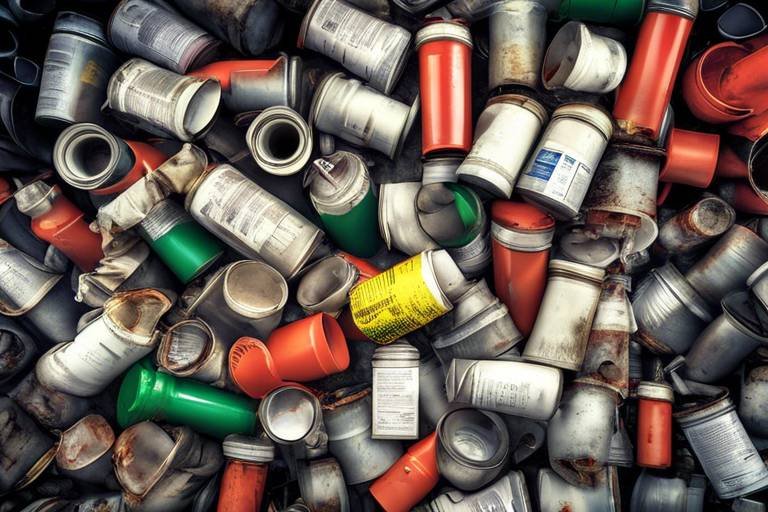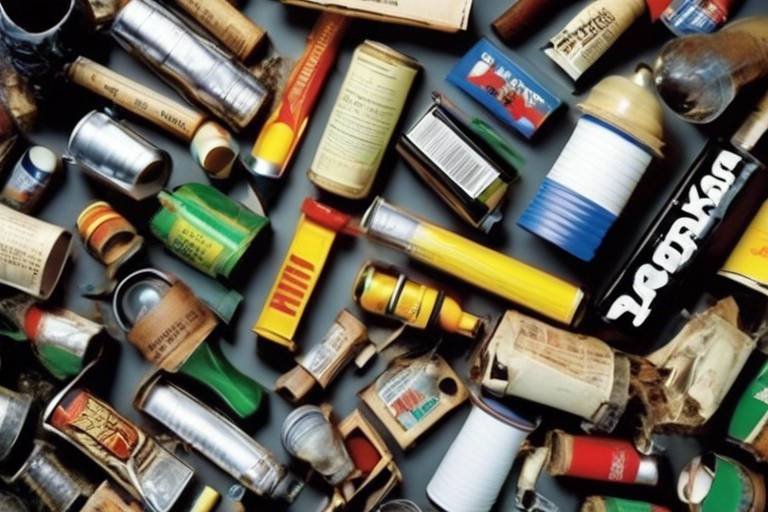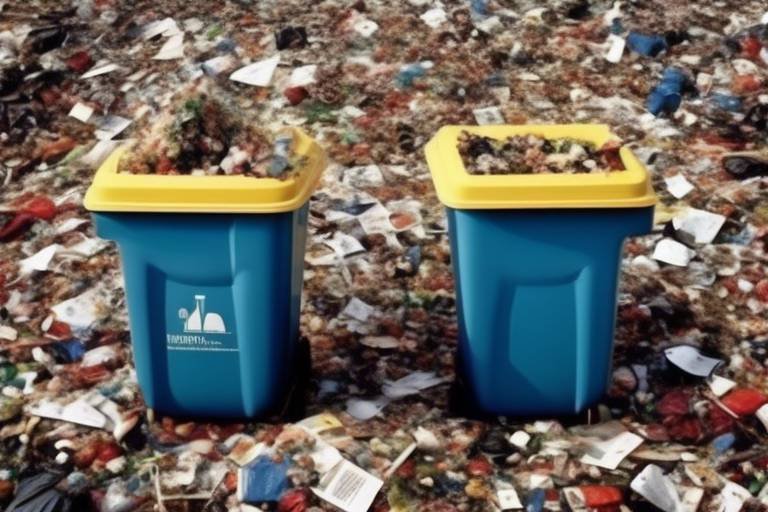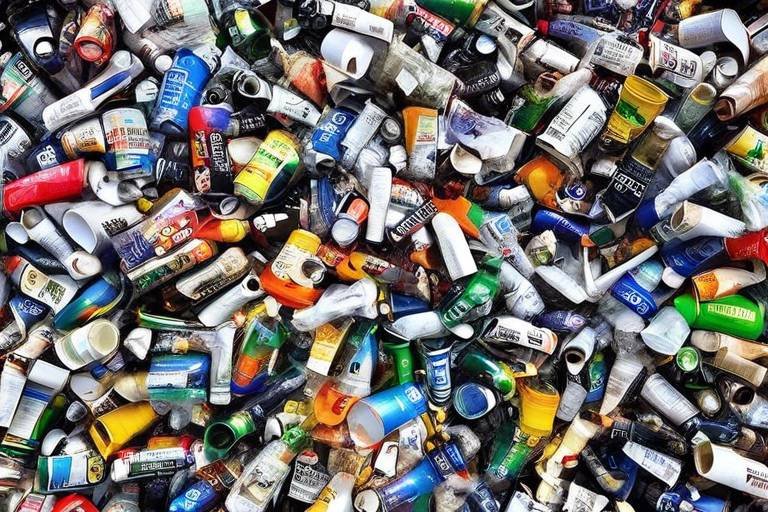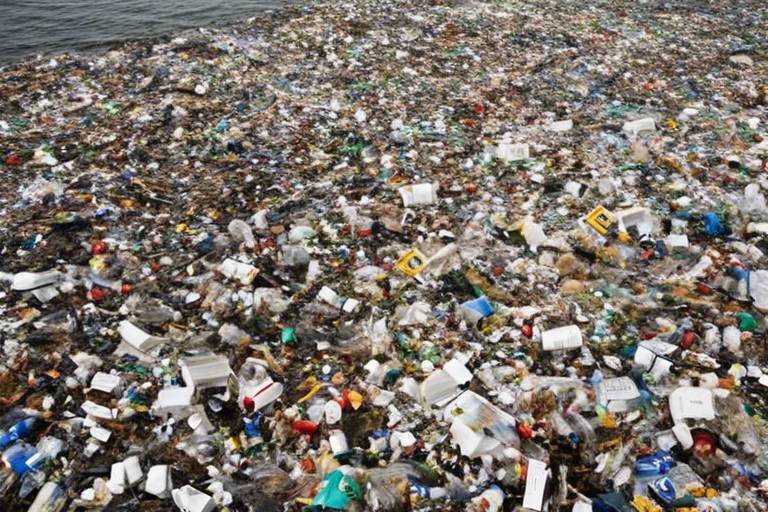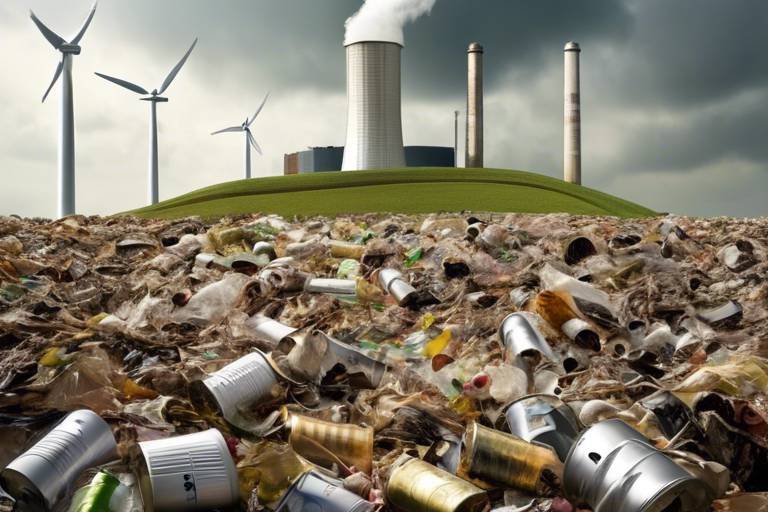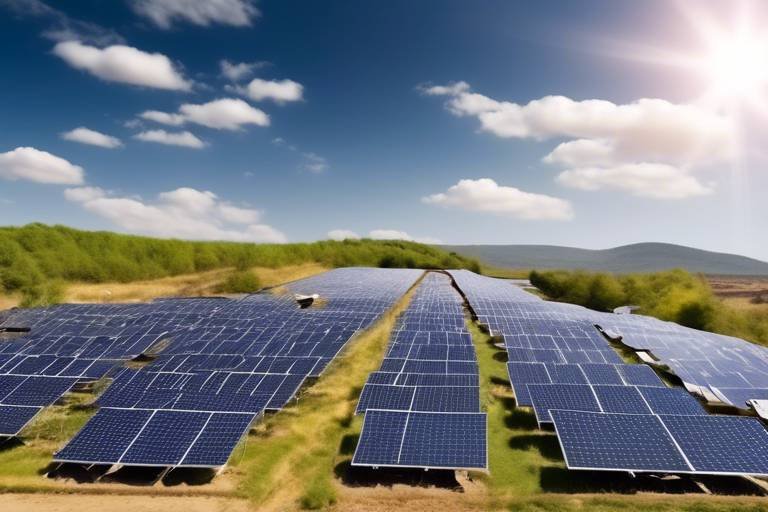What Happens to Your Recyclables After They are Collected
When you toss that empty soda can or crumpled paper into your recycling bin, have you ever stopped to wonder what happens next? It’s like sending your recyclables on a secret mission, and the journey they embark on is both fascinating and crucial for our planet. Once collected, these items don’t just vanish into thin air; they undergo a series of processes that transform them into new products. Understanding this journey is essential, not only for appreciating the recycling process but also for realizing our role in making it more effective.
First up in this journey is the collection process. Waste management services utilize a variety of vehicles, from compact trucks to larger collection vehicles, to gather recyclables from homes and businesses. These vehicles are often on a set schedule, making regular rounds to ensure that your recyclables are picked up efficiently. This is where the adventure begins, as your discarded items are whisked away to sorting facilities, ready to be processed. But before they can be recycled, they must be sorted and cleaned to ensure only suitable materials make it to the next stage.
At sorting facilities, the real magic happens. Recyclables are meticulously separated based on type and quality. This is a crucial step because contamination can significantly hinder the recycling process. Imagine a beautiful cake ruined by a single rotten ingredient! In the world of recycling, that 'rotten ingredient' could be a non-recyclable item mistakenly thrown in with your plastics or metals. Therefore, proper sorting is not just a minor detail; it’s vital for maintaining the integrity of the recycling stream.
Sorting can be performed in two primary ways: manual and automated sorting. Manual sorting involves skilled workers who carefully inspect and separate materials, identifying contaminants that automated systems might overlook. This hands-on approach can enhance the quality of the recycled materials, making them more valuable in the market. However, it can be time-consuming and labor-intensive.
On the flip side, automated sorting systems leverage advanced technology, utilizing conveyor belts, air jets, and sensors to quickly and efficiently separate recyclables. This method can significantly increase throughput and reduce labor costs. However, while automation speeds things up, it may sometimes miss certain contaminants, which can lead to issues down the line. Both methods have their pros and cons, and many facilities utilize a combination of both to optimize their sorting processes.
Quality control measures are another critical aspect of recycling facilities. These measures ensure that only high-quality materials are processed for recycling. Facilities implement various checks and balances, from visual inspections to advanced machinery, to guarantee that the materials being recycled meet industry standards. This focus on quality is essential because it directly impacts the effectiveness and economic viability of recycling operations.
Once the sorting is complete, it’s time for the recyclables to undergo processing. This involves shredding, melting, or pulping materials to prepare them for manufacturing into new products. For instance, plastics might be melted down and formed into pellets, while paper goes through a pulping process to create new sheets. This transformation not only reduces waste but also conserves valuable natural resources, making recycling a win-win for both the environment and the economy.
In conclusion, the journey of your recyclables is a complex yet rewarding process. From collection to sorting and processing, each step plays a vital role in ensuring that materials are reused rather than ending up in landfills. By understanding this journey, we can all contribute to a more sustainable future.
- What types of materials can be recycled? Common recyclables include paper, cardboard, plastics, glass, and metals.
- How can I ensure my recyclables are properly sorted? Make sure to clean and dry your recyclables and follow local recycling guidelines to avoid contamination.
- What happens if I put non-recyclables in my recycling bin? Non-recyclables can contaminate the entire batch, making it more difficult to process and potentially leading to more waste.
- Are there any new technologies in recycling? Yes, advancements like AI and machine learning are improving sorting accuracy and efficiency in recycling facilities.

The Collection Process
Understanding how recyclables are collected is crucial for appreciating the entire recycling journey. The collection process involves a well-coordinated effort between local waste management services and the community. Typically, specialized vehicles, often referred to as recycling trucks, are deployed to gather recyclables from homes and businesses. These trucks are designed with compartments to keep different materials separated during transport, ensuring that contamination is minimized right from the start.
Most waste management services operate on a regular schedule, which can vary from weekly to bi-weekly collections, depending on the locality. Residents are usually informed about their specific collection days through mailers, community boards, or local websites. This systematic approach helps maintain an organized recycling process and encourages residents to participate actively.
During collection, it’s essential for individuals to adhere to proper sorting guidelines. For instance, items such as glass, plastics, metals, and paper should be placed in designated bins. Each type of material has its own collection requirements, which can differ significantly across regions. In many cases, the recycling trucks are equipped with compaction technology that compresses materials, allowing for more efficient transport to sorting facilities. This not only optimizes space but also reduces the carbon footprint associated with transportation.
Here’s a brief overview of the typical collection process:
| Step | Description |
|---|---|
| 1. Schedule | Local waste management sets up a collection schedule for recyclables. |
| 2. Preparation | Residents prepare their recyclables by sorting them into appropriate bins. |
| 3. Collection | Recycling trucks collect the sorted materials from designated locations. |
| 4. Transport | Materials are transported to sorting facilities for further processing. |
The collection process is not just about gathering materials; it's also about fostering a culture of sustainability. Communities that actively participate in recycling programs contribute to reducing landfill waste and promoting environmental awareness. By understanding the collection process, individuals can better appreciate their role in the larger recycling ecosystem.
- How often are recyclables collected? - Collection frequency varies by location, typically ranging from weekly to bi-weekly.
- What types of materials can be recycled? - Commonly recycled materials include paper, cardboard, plastics, metals, and glass.
- What should I do if my recycling bin is full? - If your bin is full, consider reducing the amount of recyclables you generate or check if your local service offers additional collection options.

Sorting Facilities
Once your recyclables are collected, they embark on an exciting journey to sorting facilities. These facilities act as the first line of defense in the recycling process, where materials are meticulously sorted based on type and quality. Imagine a bustling hub filled with conveyor belts, where items zip by at lightning speed, and workers and machines work in harmony to ensure that only the best materials make it through to the next stage of recycling. The importance of this process cannot be overstated; proper sorting is crucial for maximizing the efficiency of recycling operations and ensuring that the materials can be effectively processed into new products.
Sorting facilities utilize a combination of manual labor and advanced technology to separate recyclables. In many cases, the facility's layout is designed to optimize the flow of materials, with various stations dedicated to different types of recyclables. For instance, you might find one area focused on plastics, another for metals, and yet another for paper products. This segregation is vital, as different materials require unique processing methods to be transformed into reusable resources. Without this careful sorting, the quality of recycled materials could suffer, ultimately impacting their market value.
But what exactly happens once the recyclables arrive at the sorting facility? Here’s a quick breakdown of the sorting process:
- Initial Screening: Upon arrival, recyclables are dumped onto a conveyor belt where large debris and contaminants are removed.
- Manual Sorting: Workers then manually sort through the materials, picking out items that don't belong, such as food containers or non-recyclable plastics.
- Automated Sorting: Advanced machinery, including optical sorters and magnets, is employed to separate materials based on their properties. For example, magnets pull out ferrous metals, while air jets can blow away lighter materials.
- Final Quality Check: Before moving to processing, the sorted materials undergo a final quality check to ensure they meet the required standards.
This meticulous sorting process not only enhances the quality of recycled materials but also reduces contamination, which is a significant issue in recycling. Contaminated recyclables can lead to entire batches being sent to landfills instead of being recycled, which is a waste of resources and effort. Therefore, sorting facilities play a critical role in maintaining the integrity of the recycling stream.
In conclusion, sorting facilities are the unsung heroes of the recycling process. They ensure that recyclables are properly sorted, reducing contamination and enhancing the quality of materials that can be processed into new products. This not only benefits the environment but also supports the recycling industry by creating high-quality materials that can be sold on the market.
Q1: What happens if recyclables are contaminated?
A1: Contaminated recyclables can lead to entire batches being sent to landfills, which defeats the purpose of recycling. Proper sorting at facilities helps to minimize this issue.
Q2: How long does the sorting process take?
A2: The time it takes can vary, but sorting facilities are designed to process large volumes of recyclables quickly, often within hours of collection.
Q3: Can I drop off my recyclables at sorting facilities?
A3: Many sorting facilities do not accept direct drop-offs from the public, as they typically work with waste management services. However, some may have designated drop-off points for specific materials.

Manual vs. Automated Sorting
When it comes to sorting recyclables, there are two main approaches: manual sorting and automated sorting. Each method has its pros and cons, and understanding these differences can help us appreciate the complexities involved in recycling operations. Imagine a bustling sorting facility where workers are meticulously examining materials, versus a sleek operation where machines whir and beep as they rapidly separate items. Which method do you think is more effective? Let’s dive into the details!
Manual sorting involves human workers physically inspecting and sorting through the recyclables. This process allows for a careful examination of each item, enabling workers to identify contaminants—those pesky non-recyclable materials that can spoil entire batches of recyclables. The human eye can catch things that machines might miss, such as greasy pizza boxes or plastic wrappers. In fact, a study showed that manual sorting can enhance the overall quality of recycled materials by up to 20%. However, this method can be labor-intensive and time-consuming, leading to higher operational costs.
On the other hand, automated sorting utilizes advanced technologies like conveyor belts, optical scanners, and air jets to separate recyclables quickly and efficiently. These systems can process large volumes of materials in a fraction of the time it takes for manual sorting. For instance, an automated facility can sort up to 50 tons of recyclables per hour, significantly increasing throughput. However, while these systems are incredibly efficient, they can struggle with accuracy. Sometimes, they may not detect certain types of contamination, which could lead to lower-quality recycled materials.
To summarize, both sorting methods have their own unique advantages and challenges. Here’s a quick comparison:
| Aspect | Manual Sorting | Automated Sorting |
|---|---|---|
| Efficiency | Lower, due to labor intensity | Higher, can process large volumes quickly |
| Accuracy | Higher, better at detecting contamination | Lower, may miss certain contaminants |
| Cost | Higher labor costs | Lower labor costs but requires investment in technology |
| Flexibility | More adaptable to different materials | Less adaptable, depends on technology |
Ultimately, many recycling facilities opt for a combination of both manual and automated sorting. This hybrid approach allows them to maximize efficiency while ensuring high-quality output. So, the next time you toss your recyclables into that blue bin, remember the intricate journey they embark on after collection. Whether sorted by hand or machine, each piece plays a vital role in the recycling process!

Benefits of Manual Sorting
When it comes to recycling, manual sorting plays a pivotal role that often goes unnoticed. Imagine a bustling sorting facility, where workers meticulously sift through heaps of recyclables, each item a potential treasure or a troublesome contaminant. This hands-on approach allows for a level of scrutiny that automated systems simply can't match. One of the primary benefits of manual sorting is the ability to identify and remove contaminated items that could compromise the quality of the recycled materials. Contaminants, such as food residue or non-recyclable plastics, can wreak havoc on the recycling process and diminish the value of the final product.
Moreover, manual sorting enhances the overall quality control of recyclables. Workers trained in identifying various materials can ensure that only the best items make it through to the processing stage. This not only boosts the marketability of the recycled products but also contributes to a more sustainable recycling system. For example, when glass is sorted manually, workers can separate colored glass from clear glass, which is crucial for producing high-quality recycled glass products.
Additionally, manual sorting allows for flexibility in handling different types of materials. While automated systems are designed to process specific types of recyclables, human workers can adapt to new materials and changing recycling guidelines with ease. This adaptability is particularly important in a world where recycling regulations and materials are constantly evolving.
It's also worth noting that manual sorting can foster a sense of community and responsibility among workers. Many employees in sorting facilities take pride in their work, knowing that they are contributing to a cleaner environment and a more sustainable future. This human element not only improves morale but can also lead to better outcomes in the recycling process.
In summary, while automated sorting systems offer speed and efficiency, the benefits of manual sorting cannot be overlooked. From enhanced quality control and contamination detection to flexibility and community engagement, manual sorting remains a vital component of the recycling ecosystem. As we strive for a more sustainable future, recognizing the importance of both manual and automated processes will be key to improving our recycling efforts.
- What is manual sorting in recycling? Manual sorting involves human workers physically separating recyclable materials based on type and quality, allowing for better contamination detection.
- Why is manual sorting important? It helps ensure high-quality recyclables are processed, reduces contamination, and allows for flexibility in handling various materials.
- How does manual sorting compare to automated sorting? While automated sorting is faster and can handle large volumes, manual sorting offers greater accuracy and the ability to identify contaminants.
- Are there any downsides to manual sorting? Manual sorting can be labor-intensive and may require more time compared to automated systems, but the quality benefits often outweigh these downsides.

Advantages of Automated Sorting
Automated sorting systems have revolutionized the recycling industry, bringing a wave of efficiency that traditional methods often struggle to match. One of the most significant advantages of these systems is their speed. Automated sorting can process large volumes of recyclables in a fraction of the time it would take human workers. This rapid processing is crucial, especially in areas with high recycling rates, as it ensures that materials are sorted and sent for processing without unnecessary delays.
Additionally, automated systems utilize advanced technologies such as optical sensors and air classifiers. These technologies allow for precise identification and separation of materials based on their composition. For instance, optical sensors can detect the specific type of plastic and sort it accordingly, which enhances the overall quality of the sorted recyclables. This level of accuracy is difficult to achieve with manual sorting, where human error can lead to contamination and lower quality outputs.
Cost-effectiveness is another crucial advantage of automated sorting. Although the initial investment in technology can be high, the long-term savings in labor costs and increased throughput can significantly offset these expenses. Automated systems require fewer workers to operate, allowing facilities to allocate their human resources to other critical areas, such as quality control and maintenance. This shift not only optimizes operational efficiency but also enhances the working environment for employees by reducing the physical demands of manual sorting.
Moreover, automated sorting systems can be programmed to adapt to various materials and changing recycling guidelines. This flexibility is essential in a rapidly evolving industry where new materials and products are constantly being introduced. By adjusting sorting parameters, facilities can ensure that they remain compliant with regulations and can efficiently process emerging materials, keeping them at the forefront of recycling innovation.
In summary, the advantages of automated sorting extend beyond just speed and efficiency. The combination of advanced technology, cost savings, and adaptability makes automated systems a vital component in modern recycling operations. As we continue to strive for better recycling practices, embracing these technologies will be key to enhancing our environmental impact and achieving sustainability goals.
- What is automated sorting in recycling? Automated sorting refers to the use of technology, such as sensors and machines, to identify and separate recyclable materials without human intervention.
- How does automated sorting improve recycling efficiency? Automated sorting systems can process materials much faster than manual sorting, reducing the time recyclables spend in the sorting process and increasing overall throughput.
- Are there any downsides to automated sorting? While automated systems are efficient, they can miss certain contaminants that a human worker might catch. Therefore, a combination of both methods is often employed for optimal results.
- What types of materials can be sorted using automated systems? Automated sorting can handle a wide variety of materials including plastics, metals, and paper, adapting to different recycling needs.

Quality Control Measures
Quality control is an essential aspect of the recycling process, ensuring that only the highest quality materials make it through to the next stages of recycling. This is crucial not only for the efficiency of the recycling operation but also for the marketability of the recycled materials. When recyclables are collected and sorted, they must meet specific standards to be processed further. If the materials are contaminated or of low quality, they can compromise the entire recycling batch, leading to increased costs and waste.
To maintain high quality, recycling facilities implement a variety of quality control measures. These measures can include:
- Visual Inspections: Workers conduct thorough visual inspections of sorted materials to identify any contaminants that may have slipped through the sorting process.
- Testing Procedures: Some facilities use testing methods to analyze the composition of materials, ensuring they meet industry standards.
- Feedback Loops: Facilities often create feedback mechanisms where workers can report issues with contamination or sorting efficiency, which helps in continuously improving the process.
Moreover, technology plays a significant role in enhancing quality control measures. Advanced sorting systems equipped with sensors and cameras can detect and separate contaminants more effectively than manual processes alone. These systems can identify various materials and automatically divert non-recyclables, thus improving the overall quality of the output. However, it’s important to note that while technology can significantly enhance sorting accuracy, human oversight remains invaluable. Workers are often better at identifying certain types of contamination that machines might miss, such as food residue or mixed materials.
In addition to sorting, facilities also implement strict processing standards. For instance, when plastics are melted down, the temperature and duration of the process must be carefully controlled to avoid degradation of the material. This ensures that the recycled product retains its integrity and can be used effectively in new manufacturing processes.
Ultimately, the success of recycling programs heavily relies on these quality control measures. By prioritizing the quality of recycled materials, facilities not only contribute to a more sustainable environment but also enhance the economic viability of recycling operations. High-quality recyclables are more valuable in the market, encouraging further investment in recycling technologies and infrastructure.
- What happens to recyclables that are contaminated? Contaminated recyclables often end up in landfills, as they can compromise the quality of the entire batch.
- How can I improve my recycling practices? Properly sorting your recyclables and rinsing out containers can significantly reduce contamination.
- Are there any new technologies in recycling? Yes, advancements in AI and robotics are improving sorting accuracy and processing efficiency in recycling facilities.

Processing Recyclables
Once recyclables have been sorted, they embark on a fascinating journey through the processing stage. This phase is where the magic happens, transforming everyday items into raw materials ready for manufacturing new products. Imagine turning your old plastic bottles into a brand-new fleece jacket or repurposing aluminum cans into a shiny new car! The processing of recyclables is not just a step; it's a crucial part of the recycling lifecycle that significantly reduces waste and conserves our planet's precious resources.
The processing methods vary depending on the type of material being recycled. For instance, plastics are typically shredded into small flakes, then washed and melted down to form pellets that can be molded into new products. On the other hand, metals are melted in large furnaces, allowing them to be reshaped into new metal products. Paper undergoes a different process, where it is pulped and then dried into sheets of recycled paper. Each of these processes plays a vital role in ensuring that recyclables are efficiently converted back into usable materials.
Here's a quick overview of the main types of recyclable materials and their processing methods:
| Material Type | Processing Method |
|---|---|
| Plastics | Shredding, washing, melting into pellets |
| Metals | Melting in furnaces, reshaping |
| Paper | Pulping, drying into sheets |
| Glass | Crushing, melting, molding |
As you can see, each material has its unique processing requirements, which highlights the importance of proper sorting at the beginning of the recycling process. If contaminants are present, they can disrupt the processing stages, leading to lower quality recycled materials. This is why public education on recycling practices is so vital; it ensures that only suitable items make it through the entire recycling journey.
Moreover, the role of technology in processing recyclables cannot be overstated. Advanced machinery and innovative techniques have revolutionized how we handle waste. For example, some facilities now use automated systems that can sort and process materials at lightning speed, significantly boosting efficiency. This means more recyclables are processed in less time, which is a win-win for both the environment and the economy.
In conclusion, the processing of recyclables is a complex yet fascinating stage of the recycling journey. It not only helps in creating new products but also plays a crucial role in reducing waste and conserving resources. By understanding and supporting this process, we can all contribute to a more sustainable future.
- What happens to recyclables after they are collected? They are taken to sorting facilities where they are separated by type and quality before being processed into new materials.
- Why is proper sorting important? Proper sorting ensures that only suitable materials are processed, reducing contamination and improving the quality of recycled products.
- What are the main types of recyclable materials? The main types include plastics, metals, paper, and glass, each requiring specific processing methods.
- How does technology improve recycling? Technology enhances sorting accuracy and processing speed, allowing for more efficient recycling operations.
- What are the environmental benefits of recycling? Recycling reduces landfill waste, conserves natural resources, and lowers greenhouse gas emissions, contributing to a healthier planet.

Types of Recyclable Materials
When it comes to recycling, not all materials are created equal. Understanding the is crucial for effective recycling practices. Each type of material has its own unique properties and processing methods, which can significantly affect the recycling process and the quality of the end product. Let's break down the major categories of recyclable materials:
1. Plastics: Plastics are one of the most common recyclable materials, but they come in various forms, each with different recycling processes. For instance, polyethylene terephthalate (PET) is widely accepted and can be recycled into new containers or clothing fibers. On the other hand, polyvinyl chloride (PVC) is less commonly recycled due to contamination issues. It's essential to check local recycling guidelines to understand which plastics can be recycled in your area.
2. Metals: Metals, including aluminum and steel, are highly valuable in recycling due to their durability and ability to be recycled indefinitely without losing quality. Aluminum cans, for example, can be melted down and reformed into new cans, saving significant energy compared to producing new aluminum from raw materials. Steel, often found in food cans and appliances, also has a well-established recycling process that conserves resources.
3. Paper: Paper recycling is another critical aspect of the recycling ecosystem. Recyclable paper products include newspapers, magazines, and cardboard. However, the quality of the recycled paper can deteriorate with each recycling cycle, which is why it's vital to maintain high-quality standards during collection and sorting. Contaminants like food residues can significantly hinder the recycling process, making it essential to keep paper clean and dry.
4. Glass: Glass is unique in that it can be recycled repeatedly without losing its integrity. Clear, green, and brown glass can all be recycled, but they must be sorted by color before processing. Glass recycling involves crushing the glass into cullet, which is then melted down to create new glass products. The recycling of glass not only conserves raw materials but also reduces energy consumption significantly.
In summary, understanding the different types of recyclable materials is key to optimizing the recycling process. By properly sorting and preparing these materials, we can enhance the efficiency of recycling operations and contribute to a more sustainable environment. Remember, the next time you're about to toss something in the trash, take a moment to consider its recycling potential!
- What types of plastics are recyclable? Most curbside recycling programs accept PET and HDPE plastics, but always check local guidelines.
- Can I recycle contaminated paper? Contaminated paper can lead to issues in the recycling process, so it's best to keep paper clean and dry.
- Is glass recyclable? Yes, glass can be recycled indefinitely, but it must be sorted by color before processing.

The Role of Technology
In today's fast-paced world, technology is not just a luxury; it's a necessity, especially when it comes to recycling. The role of technology in the recycling process has become increasingly important, revolutionizing how we manage waste and conserve resources. Imagine a bustling recycling facility where machines hum like busy bees, sorting through mountains of materials at lightning speed. This is not just a dream; it's the reality of modern recycling operations.
One of the most significant advancements in recycling technology is the introduction of automated sorting systems. These systems utilize high-tech sensors and artificial intelligence to identify various materials with remarkable accuracy. For instance, optical sorters can distinguish between different types of plastics by analyzing their color and composition. This means that what once required hours of manual labor can now be completed in mere minutes, drastically increasing efficiency. But how does this impact the overall recycling process?
First and foremost, automated systems help reduce human error. In a manual sorting scenario, fatigue can lead to mistakes, resulting in contamination of recyclable materials. However, machines don't tire. They can work tirelessly, ensuring that the quality of sorted materials remains high. This efficiency also translates to cost savings for recycling facilities, as less labor is required, allowing workers to focus on more complex tasks that machines cannot handle.
Moreover, technology enhances the processing capabilities of recyclables. For example, advanced shredders and granulators can break down materials into smaller, more manageable pieces, making them easier to melt or pulp. This is particularly true for materials like plastics and metals, which require precise processing to ensure they can be reused effectively. The result? A more streamlined process that not only saves time but also reduces the energy needed to recycle materials.
In addition to sorting and processing, technology has also paved the way for innovative recycling solutions. For instance, some companies are developing biodegradable plastics and other eco-friendly materials that can be recycled more efficiently than traditional options. With the help of technology, researchers are continually discovering new methods to improve recycling practices, making them more sustainable and effective.
To illustrate the impact of technology on recycling, consider the following table that outlines the benefits of different technological advancements:
| Technology | Benefits |
|---|---|
| Automated Sorting Systems | Increases speed and accuracy, reduces contamination, lowers labor costs |
| Advanced Shredders | Enhances processing efficiency, reduces energy consumption |
| AI and Machine Learning | Improves sorting accuracy over time, adapts to new materials |
| Innovative Materials | Creates more sustainable products, facilitates easier recycling |
In conclusion, the role of technology in recycling cannot be overstated. It not only enhances the efficiency and effectiveness of recycling processes but also opens the door to innovative solutions that can help us tackle waste management challenges. As we continue to embrace technological advancements, we can look forward to a future where recycling is not just a necessity but a seamless part of our daily lives.

The Environmental Impact
Recycling plays a pivotal role in shaping a healthier planet, acting as a powerful tool to combat environmental degradation. When we recycle, we’re not just tossing items into a bin; we’re actively participating in a process that reduces landfill waste, conserves precious natural resources, and significantly lowers greenhouse gas emissions. Imagine a world where mountains of waste are transformed into new products instead of polluting our beautiful landscapes. That’s the magic of recycling!
First and foremost, recycling helps reduce the amount of waste that ends up in landfills. Landfills are not just unsightly; they are also major sources of methane, a potent greenhouse gas that contributes to climate change. According to the Environmental Protection Agency (EPA), recycling and composting prevented the release of approximately 186 million metric tons of carbon dioxide equivalent into the air in just one year. This is like taking 39 million cars off the road for a year! Every time we recycle, we reduce the burden on our landfills and help keep our environment cleaner.
Moreover, recycling conserves natural resources. For example, recycling paper reduces the need for deforestation, which is crucial for maintaining biodiversity and protecting ecosystems. When we recycle one ton of paper, we save about 17 trees, 7,000 gallons of water, and 4,100 kilowatts of electricity. That's not just numbers; it's about preserving our forests and the wildlife that inhabit them. Similarly, recycling metals means less mining, which is an energy-intensive process that can lead to habitat destruction and pollution.
Another significant environmental benefit of recycling is its role in reducing energy consumption. The energy savings from recycling can be substantial. For instance, recycling aluminum saves up to 95% of the energy required to produce new aluminum from raw materials. This energy efficiency translates to fewer fossil fuels burned, which means a reduction in air pollution and greenhouse gas emissions. In a world where energy resources are dwindling, recycling provides a pathway to a more sustainable energy future.
However, the impact of recycling extends beyond just waste reduction and energy conservation. It also fosters a circular economy, where materials are reused and repurposed rather than discarded. This shift not only reduces the demand for new materials but also encourages innovation in product design and manufacturing processes. Companies are increasingly recognizing the value of sustainable practices, which can lead to new business models and job creation in the recycling and green technology sectors.
| Environmental Benefits of Recycling | Impact |
|---|---|
| Reduces Landfill Waste | Less methane emission, cleaner environment |
| Conserves Natural Resources | Preserves forests, reduces habitat destruction |
| Saves Energy | Lower greenhouse gas emissions, reduced fossil fuel consumption |
| Promotes a Circular Economy | Encourages sustainable practices and innovation |
In conclusion, the environmental impact of recycling cannot be overstated. It is a multifaceted approach that not only helps mitigate climate change but also conserves resources, saves energy, and promotes a sustainable future. As individuals, we have the power to make a difference. By recycling, we contribute to a healthier planet and ensure that future generations can enjoy the natural beauty that surrounds us.
- What materials can be recycled? Most common materials include paper, cardboard, glass, plastics, and metals. Always check local guidelines for specifics.
- How does recycling reduce pollution? Recycling reduces the need for new materials, which in turn lessens the energy consumption and emissions associated with manufacturing processes.
- Can recycling really make a difference? Absolutely! Recycling reduces landfill waste, conserves resources, and minimizes environmental impact, contributing to a healthier planet.

Challenges in Recycling
Despite the numerous benefits of recycling, the journey from collection to processing is fraught with challenges that can hinder its effectiveness. One of the most significant obstacles is contamination. When non-recyclable materials are mixed in with recyclables, it can spoil entire batches, making them unsuitable for processing. Imagine trying to bake a cake, but someone keeps adding salt instead of sugar. Just as that would ruin your dessert, contamination can derail recycling efforts, leading to increased costs and wasted resources.
Another challenge is the fluctuation of the recycling market. The demand for recycled materials can vary greatly, influenced by factors such as economic conditions and global market trends. For instance, when oil prices drop, the cost of new plastic products can become cheaper than recycled ones, causing recycling programs to struggle financially. This volatility can create uncertainty for recycling facilities, making it difficult for them to maintain operations and plan for the future.
Public awareness and participation also play a critical role in the success of recycling programs. Many individuals are still unclear about what can and cannot be recycled, leading to improper disposal practices. This lack of knowledge can be likened to a puzzle where some pieces just don’t fit; when people toss items into the recycling bin without understanding the rules, it complicates the entire process. To combat this, educational campaigns are essential. These initiatives can help inform the community about proper recycling practices, ultimately improving the quality of materials collected.
Additionally, the infrastructure for recycling can vary significantly from one region to another. Some areas may have advanced facilities equipped with the latest technology, while others may struggle with outdated systems. This disparity can lead to unequal recycling rates and effectiveness across different communities. In some cases, it might even be more cost-effective for certain regions to send waste to landfills rather than invest in recycling, further complicating efforts to promote sustainability.
Lastly, we must consider the environmental impact of recycling processes themselves. While recycling is generally seen as a positive practice, it is not without its environmental footprint. The energy consumed in the sorting, processing, and transporting of recyclables can contribute to greenhouse gas emissions. Therefore, it is crucial to continuously seek ways to improve efficiency and reduce the ecological impact of recycling operations.
In summary, while recycling presents a pathway to a more sustainable future, it is not without its hurdles. Addressing issues such as contamination, market fluctuations, public awareness, infrastructure disparities, and environmental impacts is essential for enhancing the effectiveness of recycling programs. With concerted efforts from individuals, communities, and policymakers, we can work towards overcoming these challenges and ensuring that recycling remains a viable solution for waste management.
- What is contamination in recycling? Contamination occurs when non-recyclable materials are mixed with recyclables, potentially ruining entire batches of materials.
- How does market fluctuation affect recycling? Changes in the demand for recycled materials can impact the economic viability of recycling programs, making it difficult for facilities to operate sustainably.
- Why is public education important for recycling? Educating the public on proper recycling practices helps reduce contamination and improves the overall effectiveness of recycling efforts.
- What are some common misconceptions about recycling? Many people mistakenly believe that all plastics are recyclable or that items don’t need to be cleaned before being recycled.

Contamination Issues
When it comes to recycling, contamination is a major hurdle that can significantly undermine the entire process. Imagine you’re at a potluck dinner, and someone accidentally brings a dish that doesn’t quite fit the theme—suddenly, the whole meal feels off! Similarly, when non-recyclable items end up in recycling bins, they can spoil entire batches of recyclables. Contamination occurs when materials that cannot be recycled are mixed in with recyclable items, leading to increased costs and reduced efficiency in recycling facilities.
One of the most common culprits of contamination is food waste. When pizza boxes, takeout containers, or other food-soiled items are tossed into the recycling bin, they can render entire loads of paper or cardboard unsuitable for recycling. This not only increases the amount of waste sent to landfills but also complicates the sorting process, as workers must identify and remove these contaminants before processing can continue.
Another issue arises with plastic contamination. Many people are unaware that not all plastics are recyclable. For instance, items like plastic bags, straws, and certain types of plastic containers can disrupt the recycling process. When these items are mixed with recyclable plastics, they can jam machinery, leading to costly downtime and labor-intensive clean-up operations. This highlights the importance of public education on what can and cannot be recycled.
To combat contamination, recycling facilities have implemented various strategies, including:
- Public Awareness Campaigns: Educating the community about proper recycling practices is crucial. Informational flyers, social media posts, and community workshops can help clarify what materials are acceptable.
- Improved Sorting Technology: Investing in advanced sorting technologies, such as optical scanners and AI-driven systems, can help identify and remove contaminants more efficiently.
- Clear Labeling: Providing clear labels on recycling bins can guide individuals on what can be recycled, reducing the risk of contamination.
In summary, contamination in recycling is a complex issue that requires a multifaceted approach. By improving public understanding and investing in better sorting technologies, we can enhance the recycling process and ensure that valuable materials are not lost in the shuffle. As consumers, we play a pivotal role in this journey. By being mindful of what we toss into our recycling bins, we can help create a cleaner, more efficient recycling system that benefits everyone.
Q1: What is contamination in recycling?
A1: Contamination in recycling refers to the presence of non-recyclable materials mixed in with recyclables. This can spoil entire batches and complicate the recycling process.
Q2: How can I reduce contamination in my recycling?
A2: To reduce contamination, always check local recycling guidelines, clean food containers before recycling, and avoid placing non-recyclable items in your recycling bin.
Q3: What happens to contaminated recyclables?
A3: Contaminated recyclables may be sent to a landfill instead of being processed for recycling, which defeats the purpose of recycling efforts.
Q4: Are there any technologies that help reduce contamination?
A4: Yes, advanced sorting technologies, such as optical scanners and AI systems, can help identify and remove contaminants more effectively during the sorting process.

Market Fluctuations
When it comes to recycling, one of the most significant challenges faced is the volatile nature of the recycling market. Just like the stock market, the demand for recycled materials can fluctuate dramatically based on various factors. For instance, the price of oil can influence the cost of virgin plastics, which in turn affects the demand for recycled plastics. When oil prices are low, manufacturers may opt for cheaper virgin materials instead of investing in recycled ones, leading to a dip in the recycling market.
Additionally, global events can create ripple effects that impact recycling programs. For example, when China implemented stricter import regulations on recyclables in 2018, it sent shockwaves through the international recycling industry. Many materials that were once easily shipped to China for processing suddenly had nowhere to go, resulting in increased costs for local recycling programs and even more waste ending up in landfills.
Another aspect to consider is the seasonal demand for certain recyclable materials. For instance, during the summer months, there is often a higher demand for aluminum cans due to increased beverage consumption. Conversely, during winter, the demand for paper products might rise as people prepare for the holiday season. This seasonal variability can lead to fluctuations in pricing, affecting the economic viability of recycling programs.
To better illustrate the impact of these fluctuations, consider the following table that summarizes the average prices of common recyclable materials over the past year:
| Material | Average Price (per ton) | Market Trend |
|---|---|---|
| Aluminum | $1,800 | ↑ |
| Plastic #1 (PET) | $300 | ↓ |
| Plastic #2 (HDPE) | $600 | → |
| Cardboard | $150 | ↑ |
| Mixed Paper | $50 | ↓ |
These fluctuations not only affect the profitability of recycling operations but also have broader implications for environmental sustainability. When recycling programs become less economically viable, communities may cut back on their recycling efforts, leading to increased waste and a negative impact on the environment. This underscores the importance of public awareness and education in supporting recycling initiatives.
In conclusion, understanding market fluctuations is essential for anyone involved in recycling. By staying informed about the factors that influence demand and pricing, communities can better navigate the challenges of recycling and continue to promote sustainable practices that benefit both the economy and the environment.
- What causes fluctuations in the recycling market? The recycling market can fluctuate due to factors such as changes in demand for recycled materials, global economic conditions, and seasonal variations in consumption.
- How do global events impact local recycling programs? Global events, such as changes in import regulations by countries like China, can significantly affect local recycling programs by limiting options for processing recyclable materials.
- Why is public awareness important for recycling? Public awareness helps ensure that people understand proper recycling practices, which can reduce contamination and improve the quality of recyclable materials, ultimately supporting the recycling market.

Future of Recycling
The is a topic that sparks excitement and curiosity, as it holds the potential to transform how we manage waste and conserve resources. With the rapid advancement of technology and a growing awareness of environmental issues, the recycling landscape is evolving in ways we could only dream of a decade ago. Imagine a world where recycling is not just an option but a seamless part of our daily lives, driven by innovative practices and smart technologies. This vision is becoming increasingly attainable as we explore new methods and policies that can enhance recycling efficiency and effectiveness.
One of the most promising trends in the future of recycling is the integration of artificial intelligence (AI) and machine learning into sorting and processing facilities. These technologies can analyze materials with incredible precision, allowing for better identification of recyclable items and contaminants. For instance, AI-powered systems can learn from previous sorting data, continuously improving their accuracy over time. This means that we can expect a significant reduction in contamination rates, which is one of the biggest challenges facing recycling today.
Additionally, the rise of circular economy models is reshaping how we think about production and consumption. The circular economy emphasizes the importance of designing products with their end-of-life in mind, encouraging manufacturers to create items that are easier to recycle or repurpose. This shift not only reduces waste but also conserves valuable resources. As consumers, we can expect to see more products that are labeled as recyclable or made from recycled materials, making it easier for us to make eco-friendly choices.
Moreover, government policies are likely to play a crucial role in the future of recycling. As awareness of climate change and environmental degradation grows, we can anticipate stricter regulations aimed at promoting recycling and reducing single-use plastics. For example, many countries are already implementing bans on plastic bags and straws, while others are introducing incentives for businesses that prioritize sustainable practices. These policies will not only encourage higher recycling rates but also foster a culture of sustainability within communities.
In terms of community involvement, educational initiatives will be key to improving recycling rates. By raising awareness about the importance of recycling and providing clear guidelines on how to do it effectively, we can empower individuals to take action. Schools, local governments, and non-profit organizations can collaborate to create engaging programs that teach people of all ages about recycling practices and the benefits of a sustainable lifestyle.
Finally, it’s important to recognize the role of innovation in materials science. Researchers are continuously developing new materials that are not only more sustainable but also easier to recycle. For instance, biodegradable plastics and packaging materials that break down naturally can significantly reduce the amount of waste that ends up in landfills. As these innovations gain traction, we can look forward to a future where recycling is not just a necessity but a natural part of our consumption habits.
In conclusion, the future of recycling is bright and full of possibilities. With advancements in technology, shifts towards circular economies, supportive government policies, increased community involvement, and innovations in materials science, we are on the brink of a recycling revolution. By embracing these changes, we can contribute to a more sustainable planet for future generations.
- What is the circular economy? The circular economy is an economic model that emphasizes the reuse and recycling of materials, reducing waste and conserving resources.
- How can technology improve recycling? Technology, particularly AI and machine learning, can enhance sorting accuracy, reduce contamination, and streamline processing in recycling facilities.
- What role do government policies play in recycling? Government policies can promote recycling through regulations, incentives, and public education initiatives that encourage sustainable practices.
- Why is community education important for recycling? Community education raises awareness about the importance of recycling, provides clear guidelines, and empowers individuals to make eco-friendly choices.
Frequently Asked Questions
- What happens to my recyclables after they are collected?
After collection, your recyclables are transported to sorting facilities where they are separated based on type and quality. This ensures that only suitable materials move on to the next stage of the recycling process.
- How are recyclables sorted?
Recyclables can be sorted manually by workers or through automated systems. Manual sorting allows for the identification of contamination, while automated sorting is faster and more cost-effective but may miss some contaminants.
- Why is proper sorting important?
Proper sorting is crucial because contaminated recyclables can compromise the quality of the recycled materials. High-quality sorting leads to better market value for recycled products and enhances overall recycling efficiency.
- What types of materials can be recycled?
Common recyclable materials include plastics, metals, paper, and glass. Each type requires specific processing methods, which can involve shredding, melting, or pulping to prepare them for manufacturing new products.
- How does technology impact recycling?
Technological advancements have significantly improved recycling processes. Innovations enhance sorting accuracy and processing speed, allowing recycling facilities to operate more efficiently and handle larger volumes of materials.
- What are the environmental benefits of recycling?
Recycling helps reduce landfill waste, conserves natural resources, and lowers greenhouse gas emissions. By recycling, we contribute to a healthier planet and promote sustainable practices for future generations.
- What challenges does recycling face?
Recycling faces several challenges, including contamination from non-recyclables, market fluctuations affecting demand for recycled materials, and public awareness about proper recycling practices. Addressing these issues is crucial for effective recycling programs.
- How does contamination affect recycling?
Contamination occurs when non-recyclable materials are mixed with recyclables. This can disrupt the recycling process, leading to increased costs and lower quality recycled materials. Public education on proper disposal is essential to minimize contamination.
- What is the future of recycling?
The future of recycling looks promising with emerging technologies and policies that aim to improve recycling efficiency. Innovations and potential legislative changes will play a key role in shaping the recycling landscape and enhancing its effectiveness.




